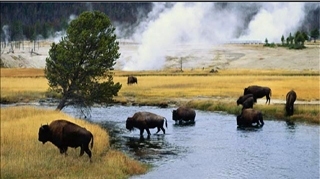|
Lincoln Highway
The Route through Buffalo County
Basically follows present-day Highway 30 with a few detours
Coming from the east:
1. Entered county south of the UP tracks at Shelton [instead of north side
as now]
a. the highway turned north on Wiseman [which is the county line] to cross
the tracks
b. at 1st St., the route turned west
to C St.
c. at C, the route turned south to
present Highway30
2. Followed Highway 30 through Gibbon to Kearney
3. East edge of Kearney on 25th St. passed the Midway Hotel
a. At 9th Ave the original route
turned south 1 block [No college curve back then]
b. then west on 24th St. on out of
town.
4. West edge of Kearney the highway followed the curving Kearney Canal.
5. At Odessa, the route turned north to 39th Rd [almost a mile]
a. 4 miles west on 39th to Cessna Rd.
b. Turn south less than a quarter of
a mile to the present Highway 30.
6. At Elm Creek, the route turned north to 56th Rd, [2/3 mile]
a. then west into Dawson County where
it merged with current Highway 30 again.
Objective of these turns through Shelton and Elm Creek were to take the
highway through the middle of town.
The first highways were routed past the businesses
With the interstate system, the businesses come to the highway.
Surfacing of Lincoln Highway
Kearney in the Gibbon to Lexington
district, a distance of 43.1 miles, all dirt.
Seeding Miles
The first Seedling Mile, a 10 foot wide
strip of paving one mile long, completed in October, 1914, west of
DeKalb, Illinois.
Nebraska was next to show interest
. Fremont, Grand Island, Kearney
Instead of 10 feet wide, Kearney made theirs 15 feet wide.
But the rest was still dirt
June, 1916 Due to heavy rains a truck became stuck in the mud on
the Lincoln Highway at Buda. It was mired in so deep the owner/driver had to
leave it there.
Mud hole in front of Winchester
residence west of Gibbon [Boyd Ranch site]
April 2, 1923 Work was progressing on the Lincoln Highway, east.
Many farmers had already set back
their fences and grading would be started shortly.
April 30, 1925 Annual Meeting of the Lincoln Highway Association
held in Kearney
More than 100 delegates
Discussion included advantages of
paving
Believed gravel or paving on Lincoln
Highway for length of state could be brought about in a year
"It was learned that within ten days or two weeks, when the Lincoln Highway
through this county is surfaced with gravel for its entire length and the
road to Pleasanton is also surfaced, Buffalo County will be further advanced
on gravel surfacing of state aid roads than another county in Nebraska."
Financing Construction &
Maintenance of Roads
Nebraska legislatures of 1869, 1871, and 1873 had said that county section
lines were to be public roads no more than trails, adequate for high -
stepping horses and slow-moving wagons
Road repair was a township
responsibility.
Various automobile clubs led to highway associations.
Sort of Chambers of
Commerce, getting their support from towns which would be on their routes.
Lincoln Highway Association NE branch one of the most active in the
country.
Brochure from the Nebraska branch -
"No other state in the Union has so many miles of level road as the Lincoln
Highway across our state,"
Soliciting funds in 1914 for planting trees along the roadside.
Inspired Watson to plant trees????
Early Roads had names, not numbers.
If they have a name today, they are old routes -
the Dixie Highway, the Yellowstone Trail, the Old Spanish trail, and the
Lincoln Highway.
Another Highway Association in
Nebraska promoted the O-L-D Highway
Omaha, Lincoln, Denver
In 1920 became the D-L-D, Detroit to Denver
Now known as US 6.
Federal Aid Road Act of 1916 provided federal funds to match state
money
Federal Aid Highway Act of 1925.
The Act established a system of numbered routes
In 1926 Nebraska highways were
numbered and marked with metal signs
Odd-numbered routes run generally north to south
Even-numbered routes run generally east to west.
|

